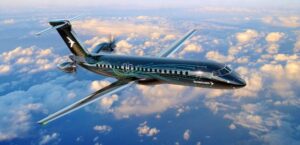What is known about Embraer’s new turboprop aircraft.
Step by step, the aircraft manufacturer reveals more details about its latest project. But what do we actually know about Embraer’s turboprop aircraft, both a private jet and regional aircraft ?
The characteristics of the new private jet
- Rear motors
- Fuel savings of up to 20%
- Both private jet and regional plane
- Supposed to fly faster than competing machines
- Maintenance should also be significantly less expensive.
The question is no longer whether the project will be realised. The question is with whom. For two years Embraer has been declaring over and over again that it wants to bring a new turboprop aircraft onto the market as a private jet and regional aircraft. And since then, the plans have become more and more concrete.
The ideas of the Brazilians have also changed during this time. Last week, Embraer suddenly showed a new arrangement of the propellers at the rear of the fuselage. On the previous designs, they were classically located on the wings. But what is really known about the project so far and where does it stand?
Designation: There is still no official name for Embraer’s new turboprop. Unofficially it is called E3 or internally Brasilhão. This is an enlargement form for the EMB 120 Brasilia. This was the turboprop aircraft that began Embraer’s rise to become a global supplier.
Programme launch: Embraer originally wanted to build the new private jet with the help of its partner Boeing, but after the takeover of the civil aircraft division by the Americans fell through, this option was dropped. The company from São José dos Campos is therefore looking for a new, smaller partner. It is said to be in advanced talks, with the start of the programme to be officially announced in 2022.
Versions: The Brazilians plan to build two versions first, a smaller one with a standard seat count of 70 and a larger one with a standard seat count of 90.
Capacity: The larger version of the turboprop aircraft will be able to carry up to 100 passengers. The largest passenger turboprop aircraft was previously a variant of the Dash 8-400, which would seat 90 travellers. But manufacturer De Havilland Canada has generally halted production of the aircraft. The ATR 72 can seat a maximum of 78 passengers.
Propulsion: Pratt and Whitney Canada has so far supplied the engines for both the ATR and the Dash 8. The Canadians are therefore in pole position. However, GE Aviation is currently developing a competing product. And the head of the engine manufacturer is John Slattery – former head of Embraer. The engines of the new turboprop aircraft will be mounted at the rear below the tail unit, as the aircraft manufacturer announced last week. This will make it quieter in the cabin, Embraer said. The company speaks of a “jet feeling”.
Wings: Unlike the Dash 8 and ATR, which are both shoulder-deckers, the wings on Embraer’s turboprop will be attached to the underside of the fuselage. Further details are not yet known.
Cabin: the fuselage is based on those of the E and E2 jets. Embraer says it wants to benefit from the advantages of the cabins of both jets. This lowers the development costs. It also creates more comfort. The E2 jets have a cabin that is 2.74 metres wide, while those of the ATR and the currently discontinued Dash 8 from De Havilland Canada are each around 2.50 metres wide. The plus allows Embraer wider seats and a more ready aisle.
Performance data
Little has been revealed here yet. Embraer is aiming for fuel savings of 15 to 20 per cent per seat compared to current turboprops. Maintenance is also expected to be significantly cheaper. Furthermore, the new aircraft is supposed to fly faster than the competition’s machines. The ATR 72 reaches 590 kilometres per hour, the Dash 8 670 kilometres per hour.

